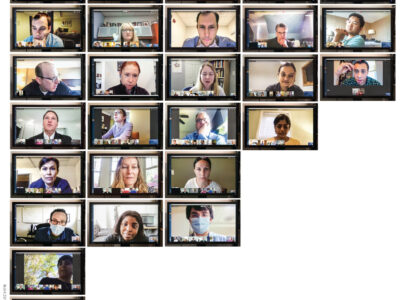
A work-from-home future could upend traditional notions about white-collar wages. Employers and employees alike should beware.
By Peter Cappelli
Until the pandemic, Facebook was paying employees a bonus to live close to its headquarters. Now, it is largely leaving the choice up to employees, with the caveat that they receive approval for remote work. That’s a big change. In noting what this means for the future, CEO Mark Zuckerberg cited “access to a wider talent pool.”
“Right now, we’re constraining ourselves to a small number of cities,” he explained. “It hasn’t been too bad of a constraint, but certainly there’s an advantage to opening up more widely.”
Some companies see permanent work-from-home arrangements as a way to attract better applicants. Yet it is hard not to believe that expanding the supply, other things equal, also leads to lower wages.
Does the virtual approach mean that we still have to stop at our national borders when it comes to employing workers? If we want to hire a worker from a foreign country, they need visas that allow them to work here, and those are limited. If they work for us remotely, however, that is no longer the case. Foreign citizens living and working abroad do not need a visa or work permit to be hired by a US company. Furthermore, income earned by a non-US citizen living and working abroad is not taxable in the US. A US company with a permanent work-from-home program could hire employees in any country.
Being able to hire people who would otherwise not want to relocate sounds great for employers—unless their competitors follow suit. In that case, their workforce also has opportunities that are unbound by location. Just as there are more possible candidates for job openings, employees also have many options to find work without having to relocate. If companies think employees are job hoppers now, wait until workers could change employers without relocating.
What we know about retention matters as well: The single most important factor holding people in organizations is social relationships. The more we and our colleagues are remote workers, the less we see of each other, and the less of that hold we have. Employees won’t be staying because they like the location or because of office perks if there is no office. Social relationships weaken when we don’t see people. Other than the work we do and money, little else holds us in place.
If your organization goes all remote and competitors do not, then this approach might work. The reverse would certainly be bad, to be the only employer hiring locally when your employees could be recruited from everywhere. If everyone moved in that direction, things could be radically different in ways that are hard to imagine: a fluid workforce constantly churning through with non-stop hiring to backfill non-stop turnover.
It is also possible that employee interest in working from home may drive employers in that direction, especially in labor markets that are well organized and where employees have good information on what competing employers are offering. We can already see some evidence for this. One example is the hiring of associates into law firms, which happens at scale, all at once, in the spring of each year. Graduates from the same schools interview at many of the same firms, and they all share information. In Philadelphia, law firms report that the 2021 graduates are asking potential employers what work-from-home policies will be. It is apparently a good job market for graduates, and the firms say that they feel some competitive pressure to offer generous policies to compete for the best candidates.
The most likely benefit for employers is that permanent work-from-home arrangements may help firms retain employees who really want to keep working from home. If companies think their competitors are going in that direction anyway, it could make sense to get ahead of the market and get some of those benefits before everyone else does the same thing. But all that assumes that remote work is actually better for job and organizational performance, or at least not worse.
One of the stranger and more contentious issues in the work-from-home debate is whether it should change the criteria we use to set pay. Specifically, will your ZIP code shape how much you are paid? The argument is that firms should pay based on the cost of living where employees live, and if workers move to a cheaper place, a company should pay them less. Facebook and Twitter announced this policy early on in the pandemic. Stripe offered to give employees a $20,000 bonus if they would move to a cheaper location and then take a 10 percent wage cut.
Here’s why none of this really makes sense in the current moment: Silicon Valley programmers and IT people are highly skilled and fit the unique needs of the companies where they are working right now. If your company did not pay them their current wage, someone else would. You are paying that wage because the market dictates it, not because the Bay Area is an expensive place to live. Bankers in New York get paid a lot because of the work they are doing, not because New York City is more expensive than, say Charlotte, North Carolina, where banking jobs are very different. In fact, one of the reasons why New York City and Silicon Valley are expensive is because people there get paid a lot of money and can bid up the price of housing.
Unlike the cost-of-living adjustments that companies used to pay when assigning managers to different locations, the companies that are thinking about paying employees based on where they live are not requiring any of those employees to live where they do. Suppose, for example, that you have a headquarters in Silicon Valley, where real estate is very expensive, and one of your employees decides to move to the Central Valley of California, where housing is much cheaper, and commute. Would you cut their pay? Should they be paid less than someone who pays a lot for a tiny house in Los Gatos but has no commute? It’s their choice. If the CEOs of these companies decided to work from their ranch in Wyoming, I am certain there would be no effort to cut their pay.
It is also something of a myth to suggest that employees in expensive locations would love the opportunity to live someplace cheaper. I have yet to hear one Wharton MBA student wax eloquently about the incredible value represented by four-bedroom ranchers in Iowa versus tiny condos in New York City. There may be people with families who really feel they need space that they cannot afford and are willing to move away from their work to do it, but this is surely not everyone. Interestingly, the companies pushing employees to move are not themselves talking about moving their operations and their leaders to cheaper locations. They just want their employees to do it.
There is one possibility as to why some employers are trying to pay employees less if they move, and it has nothing to do with the cost of living. It is the ability to extract a price from employees who would be willing to pay to live elsewhere. Rather than say that there is a 10 percent tax on working remote, a firm says that pay will be lowered to the cost-of-living where an employee works, which doesn’t sound so manipulative. They are taking advantage of evidence that many employees appear willing to pay a price to work from home, so presumably some would pay a bigger price to work from home permanently.
There is another conversation going on about the future of pay sparked by working from home that may be more explicit outside the US but is sub rosa here. It is about the inappropriateness of jobs being structured around a time clock, with one conversation driven by employees and the other by employers. Like two parallel lines, they never intersect even though they are talking about the same thing.
An Adecco international survey of 8,000 office workers and their bosses in 2020 reported both employees and executives saying that we should move away from work being based on certain hours sitting at your desk and more based on what the business actually needs.
The problem, though, is that those two groups appear to have completely different ideas as to what that would mean. White-collar workers in the US, who do not have any overtime restrictions on hours, already know that business needs can go up and up and up, pushing well past the 9-to-5 schedule, especially if the work can be done outside the office.
Peter Cappelli is the George W. Taylor Professor and director of the Center for Human Resources at the Wharton School. He is the author of The Future of the Office: Work from Home, Remote Work, and the Hard Choices We All Face (Wharton School Press). Reprinted by permission of Wharton School Press.




